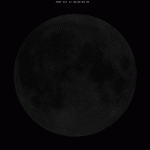Does the Moon seem a little larger and brighter than usual? It may not be an illusion, sometimes the Moon really does look a little larger or smaller in the sky.
Like all orbiting objects, the Moon does not orbit in a perfect circle, but rather in an ellipse. This means that as it orbits it is a little further away or a little closer. In the case of the Moon the difference is not much, but you can see it, if you know to look.


The period of time between full Moons, the synodic month, is about 29.5 days. While lunar perigee occurs every 27.5 days, an anomalistic month. Since these periods are not equal, the cycle drifts in and out of phase. About once a year the cycles coincide and full Moon and apogee or perigee will occur near the same time.
At apogee, the Moon will be appear about 29 arc-minutes in size, a little less than half a degree. At perigee the Moon will be about 33 arc-minutes across, a bit more than half a degree. The numbers may not seem like much, but it is a visible difference. The simulated images shown here will give a better idea of what the numbers represent.
This change in size and distance leads to the moonlight being a bit brighter at perigee than at apogee, about a 30% difference. So if that moonlit night seems brighter than you remember it may actually be the case.

